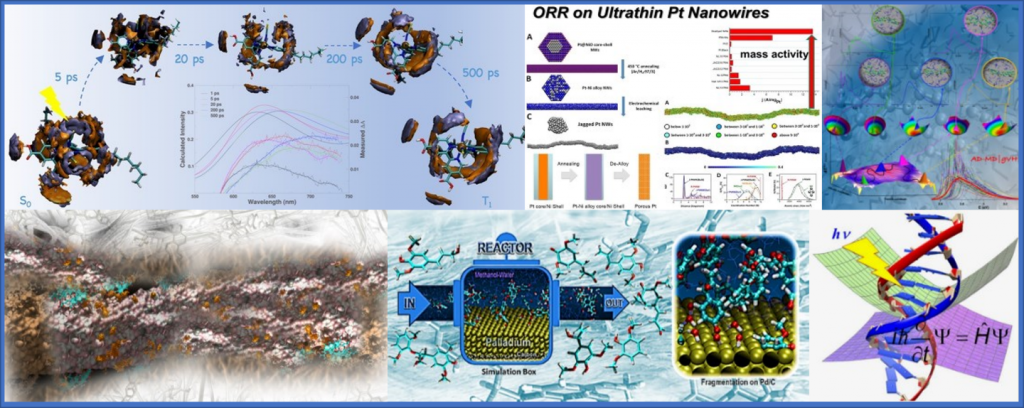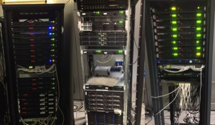Theoretical and Computational Chemistry Laboratory (ThC2-Lab)
 The THC2-Lab at the CNR-ICCOM Pisa Secondary Site involves 4 permanent and 3 fixed-term research scientists, together with numerous students and university associates, thus representing one of the largest research teams settled in a single CNR Institute and working in the field of molecular modeling and theoretical and computational chemistry.
The THC2-Lab at the CNR-ICCOM Pisa Secondary Site involves 4 permanent and 3 fixed-term research scientists, together with numerous students and university associates, thus representing one of the largest research teams settled in a single CNR Institute and working in the field of molecular modeling and theoretical and computational chemistry.
Our research is aimed at developing new theoretical and computational models and methods and their application to the study of systems and processes relevant for materials chemistry and biology, pursuing a fully dynamical description of the phenomena under investigation. We have long-standing expertise in the investigation of the linear and nonlinear optical properties of molecular dyes in complex environments, e.g. in solution, or in natural/synthetic polymeric matrix, that has been exploited to study the photochemical and photobiological behavior of DNA segments and natural pigments, as well as the properties of functionalized polymers, focusing not only on their optical response but also on the dynamical processes triggered by light absorption like, chemical reactions, internal conversions, energy, proton, and electron transfers. With this background, we recently conveyed part of our efforts to the study of model systems for dye-sensitized solar cells and artificial photosynthesis. We also have a long-standing expertise in the simulation of the structure, growth, and properties of metallic nanoclusters and nanoalloys, both free and in different environments such as colloidal and supported systems, with applications to heterogeneous catalysis processes of importance in the fields of energy and environment, and recognized results in the electrochemical Oxygen Reduction Reaction (ORR) and in the ammonia synthesis via the Haber-Bosch process. Low-dimensional (2D) materials both as supports and for their emerging properties in optoelectronics are also part of our expertise. Recently, our interest has extended to the ab initio prediction of the morphology and atomistic structure of amorphous and/or nanostructured carbonaceous phases with applications in catalysis, electrochemistry (electrodes), sensors and supercapacitors.
Our technical expertise covers many tools of computational chemistry and physics ranging from DFT, post-HF, hybrid QM/MM, plane-wave approaches for solids, implicit and explicit solvation models, classical and quantum molecular dynamics (MD). Nonetheless, a significant part of our work is devoted to developing new models, methods, and computational protocols. We have designed methods to optimize force fields for MD and to simulate vibronically resolved electronic spectra in large flexible systems, diabatization and fragmentation, methods to evaluate electronic couplings for electron and energy transfers, (reactive) global optimizations algorithms for the exploration of multi-minima potential energy surfaces typical of nanoclusters and nanoalloys, methods for high-throughput screening aimed at the rational design of novel catalytic systems, and Machine Learning techniques. Some of these developments have been implemented in open-source codes that are freely shared with the scientific community.

Areas of application
- Developments of models and methods
- Materials Chemistry
- Energy
- Photochemistry, Photobiology and Photophysics
- Biosensors
- Molecular electronics
- Metal nanoclusters and nanoalloys
- 2D Materials (oxides, dichalcogenides, graphene)
- Systems of biological relevance
- Computational spectroscopy
- Rational Deisgn in Catalysis
- Self-assembled materials
- Liquid Crystals
- Transition metal compounds for photovoltaics
Expertise
- postHF and DFT based methods for molecular properties in electronic excited states
- Molecular dynamics and development of force fields
- Plane-wave DFT methods for solids and clusters
- Implicit and explicit solvation models
- Conical Intersections, quantum and semiclassical dynamics of nonadiabatic processes
- Vibrational and electronic spectroscop
- Transitions from metastable states
- Drug design
- Multi-scale and mixed quantum-classical (MQC) methods
- Accelerated dynamics and stochastic sampling techniques
Instruments

- Cluster SoBaSV (440 cores + 30 TB storage)
- 4 nodes/128 cores CPU Intel® Xeon® Silver 4216 a 2.10 GHz, 128 GB RAM, 1 TB SATA HD (Vanz1-4)
- 4 nodes/112 cores CPU Intel® Xeon® CPU E5-2680 v4 a 2.40 GHz, 128 GB RAM, 2 TB SATA HD (Sacco1-4)
- 4 nodes/64 cores CPU Intel® Xeon® CPU E5-2640 v3 a 2.60 GHz, 128 GB RAM, 2 TB SATA HD (Baleno5-8)
- 4 nodes/64 cores CPU Intel® Xeon® CPU E5-2670 a 2.60 GHz, 128 GB RAM, 2 TB SATA HD (Baleno1-4)
- 6 nodes/72 core CPU Intel® Xeon® CPU E5650 a 2.67 GHz, 48 GB RAM, 250 GB SATA HD (Sole)
- Cluster MODULO
- 16 nodes/128 CPU Quad-Core AMD Opteron Processor 2380, 32 GB RAM, 250 GB SATA HD
- Cluster CRESCITA
- 12 nodes/96 CPU Processore AMD Opteron 2354, 16 GB RAM, 250 GB SATA HD
- 4 nodes / 16 CPU Processore AMD Opteron 265, 8 GB RAM, 250 GB SATA HD
- DPM cluster
- 8 nodes/64 core CPU Tower HP BladeSystem c3000, 8x HP ProLiant BL460c G1 (2x Intel(R) Xeon(R) CPU E5440 a 2,83 GHz, 16 GB RAM 150 GB SATA HD)
- FORM e NEWGROWTH clusters
- 16 nodes / 128 CPU Quad-Core AMD Opteron Processor 2380, 32 GB RAM, 250GB SATA HD – Collegamento InfiniBand
- 4 Nodes / 16×2 core – 2 Intel(R) Xeon(R) Gold 6130 CPU @ 2.10GHz – 256 GB RAM – 200GB SATA HD + 4 Nodes / 26×2 core – 2 Intel(R) Xeon(R) Gold 6230R CPU @ 2.10GHz – 192 GB RAM – 100GB SSD + 3 Storage Areas 3.5 TB SATA HD – Link InfiniBand
Permanent Staff
- Alessandro Fortunelli, Research Director
- Samuele Giannini, Fixed-term Researcher
- Jacopo Lupi, Fixed-term Researcher
- Susanna Monti, Research Director
- Giacomo Prampolini, Senior Researcher
- Thantip Roongcharoen, Fixed-term Researcher
- Fabrizio Santoro, Research Director
- Giovanni Villani, Senior Researcher
